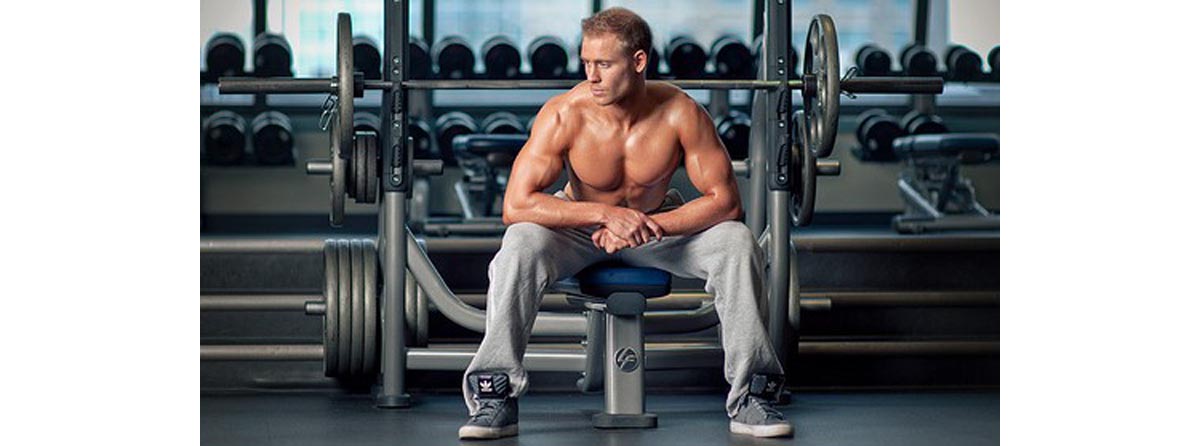Myths about building muscle abound — and they can cause you either to waste time and money or to follow unnecessarily complicated muscle-building routines or to take supplements that don't really work. Here are seven of the most commonly repeated myths about muscles, debunked, so you don't waste your time as you build bulk.

Muscle Myth #1. You can lose fat and build muscle at the same time.
Most of us want instant results when we set out to get back into shape, sometimes after a long period of near complete inactivity with accompanying fat stores. We want trimmer waistlines, firmer thighs, and we want to lose the excess bulk in our behinds. We want to lose fat and build muscle at the same time. Unfortunately, that is just not the way in which the body is set up metabolically.
Before our bodies can burn fat, our fat cells have to liquify it so it can be transported to the muscles for fuel. The liquification process for fat only takes place when a fat-dissolving enzyme is activated. For this to happen, insulin levels have to be low. However, muscles absorb amino acids to make protein (for strength) and glucose to make glycogen (for bulk) only with the help of insulin.
Muscle Myth #2. Getting back into shape is easier if you have ever been in shape because your muscles "remember" how to be big and just need to be reactivated with a protein shake.
There really are not any tiny little brains in your muscles. It just isn't true that muscles "remember" being in good shape, although it is true that your brain will remember the correct way to perform an exercise, which is what "muscle memory" means. However, if you have ever built muscle, you have activated DNA in your muscles that can be quickly reactivated as long as you work out, and work out hard. But the added advantage of having ever once been in good shape is limited to faster protein synthesis in muscle in response to exercise.
Muscle Myth #3. There's a single best time of day to exercise.
It's true that the "fast twitch" fibers in muscles are less active in the morning and more active in the late afternoon. That's because it's easier for muscles to generate the energy they need for quick movement when they are warmer, and body temperature is lowest in the early morning but peaks late in the day. However, for most kinds of muscle building exercise, speed is not essential, and the muscle-building effects of resistance exercise are the same any time of day.
Four More Myths About Building Muscle Busted
Muscle Myth #4. Protein is bad for your kidneys.
One of the basic arguments in favor of vegan diets — which are not impossible for muscle-builders, as Googling "vegan body builder" will quicky reveal — is that excess protein from meat, fish, eggs, and dairy burns out your kidneys. However, when researchers tested kidney function in body builders who used protein powders after they worked out, no kidney damage was detected.

If you have advanced kidney disease, you almost certainly do need to limit your protein intake, but it is also highly unlikely that you will be working out. If you believe it is immoral to eat animals, by all means pursue a vegan diet, but don't harbor unnecessary fear of burning out your kidney function by consuming a high-protein diet.
Muscle Myth #5. You can gain 30 pounds of muscle in 30 days by working out 30 minutes a day.
Sorry, muscles just can't build themselves that fast. And if you work out every day for 30 days without rotating the exercises so your muscles have a recovery period at least every other day, you might even lose muscle in that period of time.
A few people are able to add about 30 percent to their muscle mass in 12 weeks. Most people can add about 10 percent more muscle in 12 weeks. Some people following the exact same program might add just a single pound of muscle in a 12-week period. Genetics make a difference, and there's nothing you can do about that except to be patient.
The idea is to develop a long-term routine, not to look for a quick fix. Focusing on a qiuck fix will leave you disappointed and likely to revert to your unfit former self.
Muscle Myth #6. Build up muscle to burn fat.
"Put on 10 pounds of muscle and your body will burn an extra 1000 calories a day!" a fitness guru tells us. The problem with statements of this isn't that muscles don't burn fat. Provided (1) you go without eating long enough that fat cells release stored fat, that is, you don't indulge in midnight snacks and (2) you actually get out and do some exercise once the fatty acids get into your bloodstream, an extra pound of muscle might burn 10 calories per day.
This means that over the course of 1 or 2 years, an extra pound of muscle may help you burn an extra pound of fat — provided you don't eat all the time and you occasionally exercise. You can't bulk up and then start living on the couch and expect to lose fat.
Muscle Myth #7. You should never exercise more than 45 minutes at a time.
If you struggle to exercise 4 or 5 minutes at a time, you may wonder why this advice is offered, but many fitness experts opine that long exercise sessions (1) increase the stress hormone cortisol and (2) especially in men, reduce the muscle-building hormone testosterone. The truth is, longer workouts do increase cortisol levels. However, higher cortisol levels are associated with increased lean body mass. If you are concerned about putting on fat, don't eat as much, because you get fat through your diet.
Testosterone levels in men actually increase in exercise sessions of up to 2 hours. It isn't necessary or helpful to work out all day long, but there is no need to hit the showers if you are feeling fine 45 minutes into your exercise routine.
- Fatouros IG, Taxildaris K, Tokmakidis SP, Kalapotharakos V, Aggelousis N, Athanasopoulos S, Zeeris I, Katrabasas I. The effects of strength training, cardiovascular training and their combination on #exibility of inactive older adults.Int J Sports Med. 2002 Feb. 23(2):112-9.
- Prior BM, Modlesky CM, Evans EM, Sloniger MA, Saunders MJ, Lewis RD, Cureton KJ. Muscularity and the density of the fat-free mass in athletes J Appl Physiol. 2001 Apr
- 90(4):1523-31.
- Photo courtesy of Jay by Flickr : www.flickr.com/photos/thephotofiend/6950775849/
- Photo courtesy of Guillermo Barrios del Valle by Flickr : www.flickr.com/photos/altamar/3614810134/


Your thoughts on this